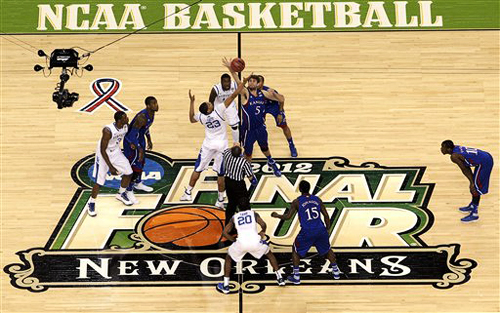The road to the Final Four started on Sunday. That’s very unofficial, of course, but it’s the time of year that conference play is at its zenith, contenders have emerged and are rounding into form, and a growing list of bubble teams are jostling for a precious spot in the NCAA men’s basketball championship. On Feb. 10 each year, the finish line comes into view on the horizon. That’s where we’re headed. It’s still the regular season, but it is exciting, and we should pay attention.
March Madness approaches

The road to the Final Four started on Sunday. That’s very unofficial, of course, but it’s the time of year that conference play is at its zenith, contenders have emerged and are rounding into form, and a growing list of bubble teams are jostling for a precious spot in the NCAA men’s basketball championship. On Feb. 10 each year, the finish line comes into view on the horizon. That’s where we’re headed. It’s still the regular season, but it is exciting, and we should pay attention.
I say this by way of reminder, because it can be very easy to forget (or entirely ignore) how compelling college hoops can be. Here in Pac-12 country, we are “treated” to a fast-fading Oregon Ducks team, an overhyped and underperforming UCLA squad and a paper tiger contender in Arizona. Gonzaga has perennial swagger, and they are excellent again this year, but by virtue of their size and relative obscurity, they don’t get much attention one way or another—the media politely does them the courtesy of an appropriate ranking and then quietly turns its back.
The other thing that works against college basketball is that our collective perception is skewed by our relationship with football. We love college football passionately; we intuitively understand the hierarchy of power in the game. We know Alabama, Notre Dame, Florida, Ohio State. We understand what those programs mean in the idiom of college football, and we get confused when schools like Boise State or Rutgers or Oregon State disrupt that understanding. We may profess to hate the dominance of the big boys, but we ultimately prefer it.
College basketball subverts this institutional understanding. The single most compelling thing about the sport is its giant single-elimination tournament, a format that mixes up conferences and styles and always, always yields dramatic upsets. We love college basketball because there’s something special about Virginia Commonwealth or George Mason or Butler making it to the Final Four. We never root for that kind of thing in college football; the whole system is designed to discourage the disruption of order. We love it in basketball.
But that puts regular season college basketball in a weird spot. A disproportionate amount of attention is placed on the season’s finale, and a great deal of that excitement is reserved for whatever plucky underdog makes a great March run from a 12-seed to the championship round. Being an underdog, though, usually means an entire 30-game season toiling in unheralded, out-of-the-way conferences against generally inferior competition. Easy to ignore that kind of regular season.
And the major conferences in college basketball lack the visceral, cultural identity of, say, SEC football. Many of the most storied and continually successful programs are in landlocked Middle America, and they simply don’t resonate as strongly as their football counterparts. This year, the Big Ten is by far the nation’s finest basketball conference, but teams like Michigan State, Wisconsin, Minnesota, Ohio State and Illinois, while testaments to the staggering depth and true excellence of the conference, just don’t conjure strong feelings throughout the country. Of the seven schools likely to represent the Big Ten in March, perhaps only Indiana and Michigan enjoy any kind of nationally understood relationship to greatness or larger narrative. Other great, big-conference basketball programs like Florida, Kentucky, Syracuse and Connecticut have left almost no imprint on the cultural landscape. There is no “Roll Tide” or waking of echoes in college basketball.
No, college basketball has a tournament, and I don’t mean to diminish that at all. March Madness is probably the greatest sporting event of the year. College basketball, even if it doesn’t share the same rarified air as football in our consciousness, still has an enormous impact and storied history. Almost all of that history centers upon things that happen for three glorious weeks every March, and it’s special and unique and thrilling.
It just puts a little damper on the regular season, perhaps rightfully so. Maybe we don’t need to pay attention to the whole season. But from now until the beginning of April, those who can spare an evening for regular-season college hoops will be rewarded. Just a friendly reminder.




